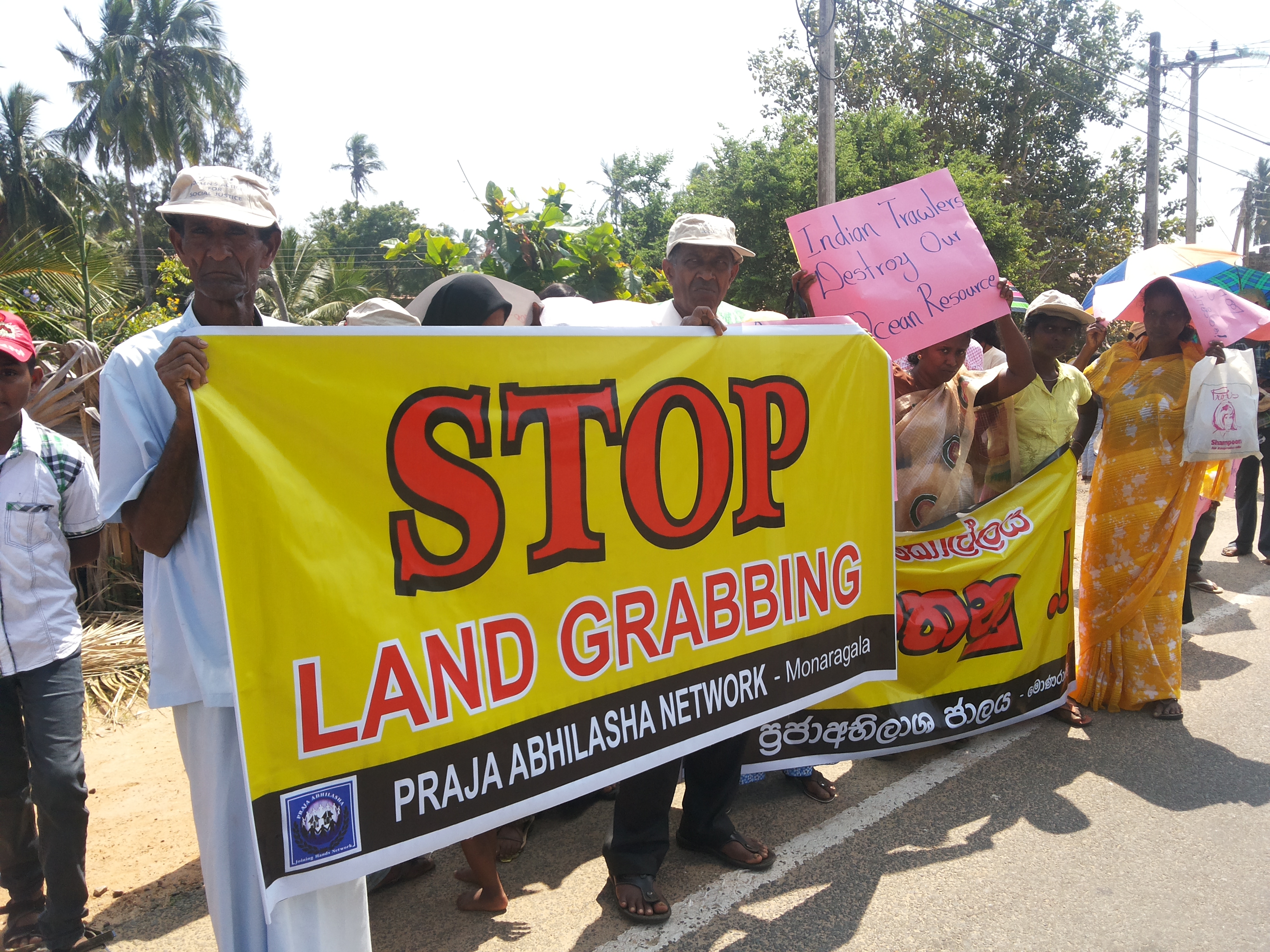By Herman Kumara, Convener, NAFSO, Chair Person, Praja Abilasha Network, JH Sri Lanka

Praja Abhilasha organizes the Paanama people in a demonstration against land grabbing in Pothuwil, Ampara. Photo courtesy of Francis Raajan.
On January 9, 2015, Sri Lankans ousted incumbent President Mahinda Rajapaksa, who ruled by authoritarianism, and voted Maithripala Sirisena into office. With the election of Sirisena came some major gains for land rights in Sri Lanka.
On February 11, 2015, the Sri Lankan Cabinet voted to release some of the lands and properties that had been confiscated in the establishment of High Security Zones (areas controlled by the military) during the 26 years (1983 – 2009) of the Eelam wars between Sri Lankan state forces and the Liberation Tigers of Tamil Eelam (LTTE).
As of February 2015, more than 90,000 people remain internally displaced from war, suffering from lack of basic facilities, security and livelihood assistance.
The Ministers approved the proposal made by President Sirisena and the Minister of Defense to release 1,000 acres of land in the Jaffna High Security Zones in stages.
As a first step, 220 acres of land in the Valalai Grama Niladhari Division of the Valikamam East Divisional Secretariat Division will be released to establish a pilot village for the resettlement of 1,022 families displaced by the War.
Under this project each family will get 20 perches (1/8 of an acre) of land, and financial assistance to construct a house. It is also proposed to establish a school, a preschool, a hospital, religious places of worship, community centers and build other infrastructure. The remaining 780 acres of land will be used in the future to resettle people displaced by the war.
A large extent of land from the 11,639 acres that were under the control of the security forces during the war period has already been released and 6,152 acres in Palay area is being maintained by the Sri Lanka Army and the Sri Lanka Air Force as High Security Zones.
Furthermore, it was also decided to release all but 25 acres of land under the control of the Air Force in the Paanama area in the Eastern Province to landless people.
“We are happy to see the cabinet decision over release of 340 acres land in Paanama. We want to emphasize this as a victory though … there are another 3 villages waiting to get their land back,” says Somasiri, leader of the Paanama Pattu Protection Organization after the announcement of the cabinet decision.
Praja Abhilasha (PA), the Sri Lankan Joining Hands network of the Presbyterian Hunger Program, has been focusing its work on land rights since 2005 after the 2004 Asian Tsunami. PA has been partnering with communities in Paanama, Sampur, Kalpitiya, Valikamam North and Mullikulam not only on land grabbing related to High Security Zones, but also land grabbing for tourist resorts and industrial agriculture projects.
Leading up to the election, PA and the National Fisheries Solidarity Movement (NAFSO) worked with 112 civil society organizations to ensure that the opposition candidates were aware of their land rights demands and, as a result, land rights became a central issue in the election campaigns.
Despite the gains, it is clear that the new government does not want to disturb investments in areas where people have been displaced.
While attending the victorious celebrations at the ancient temple in Paanama, with a crowd of more than 500 people gathered, Mr. Daya Gamage, the opposition leader of the Eastern Provincial Council said, “Prime Minister Ranil Wickramasinghe has instructed me to tell you all that there will be more land released after studying the ground situation. But, there are certain difficulties as there are some investments such as the construction of 57 chalets and we will need to clear all those before we take any decision to release the other 25 acres in the area.”
Francis Raajan, the coordinator of the PA network says, “This is a great victory for the land struggle in Paanama. PA engaged in this struggle mobilizing people in many ways. Collective action, unshaken community leadership, and building a strong social movement were key factors that led to the victory. We want to continue the struggle further and we appeal to the international community to extend your hands to strengthen the struggle.”
At the capacity building of activists on Voluntary Guidelines of Governance of Tenure (VGGT), Somasiri said, “This is a victory indeed. Now the challenges are more serious as we elected this government and the people expect some deliverables. It is just a beginning of a series of other victories. But we need to move further, until we win our struggle fully.”
The challenges are ahead of us and we need more courage and determination to win. We fought during the time of the dictator regime without fear. Now, we have made a democratic space to struggle for our rights.
![]() You may freely reuse and distribute this article in its entirety for non-commercial purposes in any medium. Please include author attribution, photography credits, and a link to the original article. This work is licensed under a Creative Commons Attribution-NonCommercial-NoDeratives 4.0 International License.
You may freely reuse and distribute this article in its entirety for non-commercial purposes in any medium. Please include author attribution, photography credits, and a link to the original article. This work is licensed under a Creative Commons Attribution-NonCommercial-NoDeratives 4.0 International License.